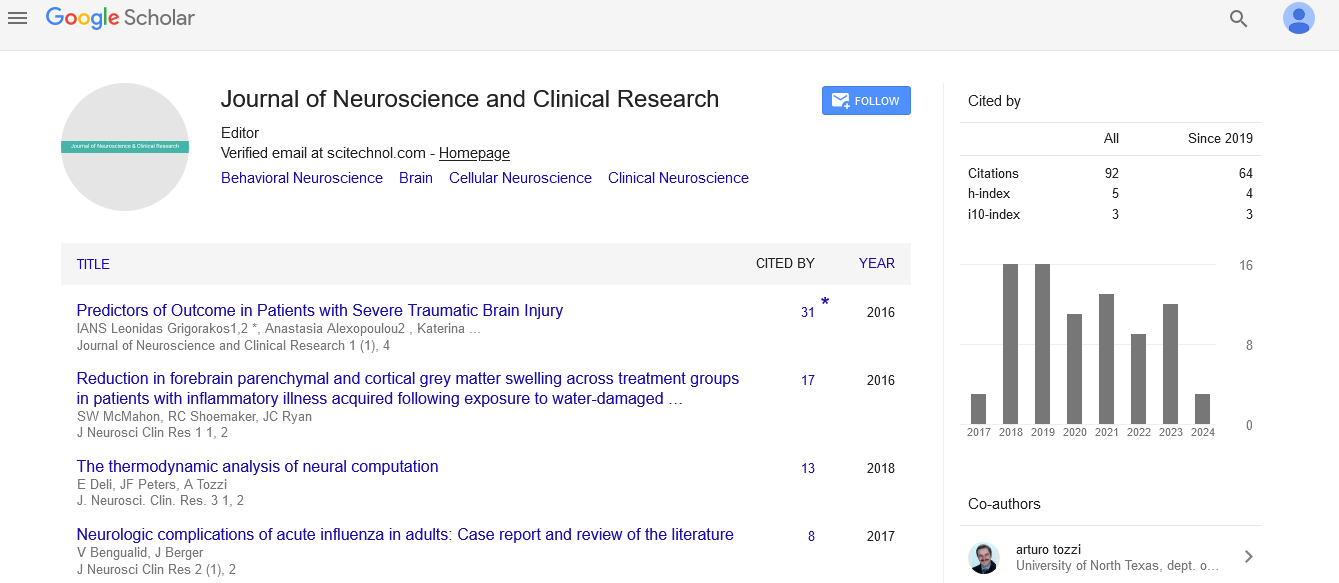Opinion Article, J Neurosci Clin Res Vol: 9 Issue: 2
Emerging Technologies in Molecular Neurobiology: From CRISPR to Single-Cell Sequencing
Kuzmenkov Vasilevskiae*
1Department of Neurology, Yale University School of Medicine, New Haven, CT 06510, USA
*Corresponding Author: Kuzmenkov Vasilevskiae,
Department of Neurology,
Yale University School of Medicine, New Haven, CT 06510, USA
E-mail: vasilevskiae@gmail.com
Received date: 28 May, 2024, Manuscript No. JNSCR-24-137117;
Editor assigned date: 30 May, 2024, PreQC No. JNSCR-24-137117 (PQ);
Reviewed date: 14 June, 2024, QC No. JNSCR-24-137117;
Revised date: 21 June, 2024, Manuscript No. JNSCR-24-137117 (R);
Published date: 28 June, 2024, DOI: 10.4172/Jnscr.1000194
Citation: Vasilevskiae K (2024) Emerging Technologies in Molecular Neurobiology: From CRISPR to Single-Cell Sequencing. J Neurosci Clin Res 9:2.
Description
The field of molecular neurobiology has undergone a revolution in recent years, driven by advancements in technology. These innovations have provided researchers with powerful tools to unravel the complexities of the nervous system at the molecular level. From manipulating genes with precision to analyzing the transcriptomes of individual cells, emerging technologies are reshaping our understanding of brain function and dysfunction. In this article, we explore two cutting-edge techniques-CRISPR gene editing and singlecell sequencing-and their applications in molecular neurobiology. Revolutionizing Gene Editing Clustered Regularly Interspaced Short Palindromic Repeats (CRISPR) technology has transformed the landscape of molecular biology, offering a versatile and precise tool for genome editing. Originally discovered as a bacterial immune system, CRISPR has been repurposed for targeted manipulation of genes in a wide range of organisms, including humans. In neuroscience, CRISPR has enabled researchers to investigate the roles of specific genes in brain development, function, and disease.
One of the most significant applications of CRISPR in molecular neurobiology is the generation of genetically modified animal models. By introducing precise mutations or gene knockouts, researchers can elucidate the functions of individual genes in the nervous system. These animal models provide valuable insights into the genetic basis of neurological disorders such as Alzheimer's disease, Parkinson's disease, and autism spectrum disorders. Moreover, CRISPR technology allows for the correction of disease-causing mutations, offering potential therapeutic avenues for genetic disorders. Single- Cell Sequencing Unraveling Cellular Diversity Traditional (UCDT) bulk RNA sequencing provides valuable insights into gene expression patterns in tissues or cell populations. However, it lacks the resolution to capture the heterogeneity present at the single-cell level. Single-cell sequencing technologies have emerged as a powerful tool to overcome this limitation, enabling researchers to profile the transcriptomes of individual cells within complex tissues like the brain.
In neuroscience, single-cell sequencing has revealed the remarkable diversity of cell types that comprise the nervous system. By dissecting the molecular profiles of neurons, glial cells, and other cell types, researchers can identify unique gene expression signatures associated with different cell populations and states. This newfound understanding of cellular diversity is transforming our knowledge of brain development, circuitry, and disease. Applications and Future Directions: The integration of CRISPR gene editing and single-cell sequencing holds immense promise for advancing our understanding of molecular neurobiology. By combining these technologies, researchers can manipulate specific genes in individual cell types and then analyze the molecular consequences at single-cell resolution. This approach enables the study of gene function within the context of complex cellular networks, providing insights into the mechanisms underlying brain development, function, and dysfunction.
Furthermore, emerging technologies such as spatial transcriptomics and multimodal single-cell analysis are poised to further revolutionize our understanding of the nervous system. Spatial transcriptomics techniques allow researchers to map gene expression patterns within intact brain tissues, providing spatial context to molecular data. Meanwhile, multimodal single-cell analysis enables the simultaneous profiling of multiple molecular features within individual cells, offering a more comprehensive view of cellular identity and function.
Conclusion
Emerging technologies in molecular neurobiology, such as CRISPR gene editing and single-cell sequencing, are transforming our understanding of the nervous system. By enabling precise manipulation of genes and comprehensive profiling of individual cells, these techniques are uncovering the molecular mechanisms that underlie brain function and dysfunction. As these technologies continue to evolve and become more accessible, they hold the potential to revolutionize our approach to studying and treating neurological disorders.
 Spanish
Spanish  Chinese
Chinese  Russian
Russian  German
German  French
French  Japanese
Japanese  Portuguese
Portuguese  Hindi
Hindi 